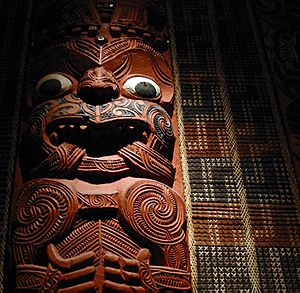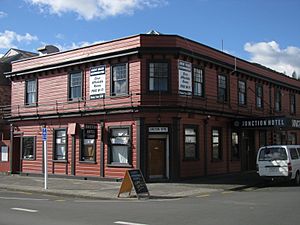Thames, New Zealand facts for kids
Quick facts for kids
Thames
Pārāwai (Māori)
|
|
|---|---|
| Country | New Zealand |
| Region | Waikato Region |
| District | Thames-Coromandel District |
| Ward | Thames ward |
| Community Board | Thames Community |
| Electorates |
|
| Area | |
| • Total | 16.99 km2 (6.56 sq mi) |
| Population
(June 2023)
|
|
| • Total | 7,630 |
| • Density | 449.1/km2 (1,163.1/sq mi) |
| Postcode(s) |
3500, 3540
|
Thames (pronounced 'Tems') is a town in New Zealand's North Island. It's located at the bottom of the Coromandel Peninsula, near where the Waihou River meets the Firth of Thames. Thames is the main town for the Thames-Coromandel District Council. The local Māori group, called an iwi, is Ngāti Maru. They are part of a larger group of tribes known as the Hauraki Iwi.
Back in 1870, Thames was a very busy place with about 15,000 people. This was during the gold rush! The population went down after that, but it's still the biggest town on the Coromandel Peninsula today.
Contents
People and Population in Thames
Thames covers an area of about 17 square kilometers. As of 2018, around 7,293 people live here.
The town's population has slowly grown over the years. In 2006, there were 6,930 people, which increased to 6,951 in 2013, and then to 7,293 in 2018.
Most people in Thames are of European background (about 82%). About 22% are Māori, and smaller numbers are from Pacific Islands or Asia. Many people in Thames (about 48%) say they don't have a religion, while about 38% are Christian.
History and Culture of Thames
Māori History in the Area
In the early 1800s, the Ngāti Maru people lived in this area. They built a large, strong fort called Te Tōtara between the Kauaeranga and Waihou Rivers. In 1821, during a time of wars called the Musket Wars, another Māori group attacked Te Tōtara.
How European Settlers Arrived
Thames was actually formed from two older towns, Grahamstown and Shortland. Many of their original buildings are still standing. Shortland was founded first, in 1867. A man named James Mackay made a deal with the local Māori to rent their land for mining. The Māori were paid a huge amount of money – £5,000 a year! This agreement allowed the Thames Goldfield to open.
Grahamstown was started the next year, a little further north. The two towns joined together in 1874 because most of the gold was found in Grahamstown.
The Gold Rush Era
Thames grew very quickly because of a gold rush. The first big discovery of gold happened in August 1867. The mine that started from this discovery produced a lot of gold. From 1868 to 1871, Thames was booming, with gold production worth over a million pounds! In total, the Thames mines produced gold worth about $845 million.
Because of the gold, Thames had about 15,000 people in 1870, making it one of the largest towns in New Zealand at that time. But as the gold ran out, the population dropped. By 1881, there were only about 4,500 people.
The land where the gold was found belonged to Māori families, including the Taipari family. In 1878, a special meeting house called Hotunui was built in Thames. It was made by carvers from the Ngāti Awa tribe and is now kept at the Auckland War Memorial Museum.
Recent Events in Thames
A large sawmill near Thames closed in 2008, which meant 145 people lost their jobs. In 2012, a sink hole appeared on a main road north of Thames. It turned out to be above an old mine shaft!
Marae and Culture
The Mātai Whetū Marae is a special meeting place for the Ngāti Maru people. It has a beautiful meeting house called Te Rama o Hauraki.
The Treasury Archive
The Treasury is a place in Thames that keeps old records and helps people research the town's history. It opened in 2009.
Steampunk Festival
Since 2015, Thames has hosted a fun Steampunk festival. People dress up in cool costumes that mix old Victorian styles with futuristic gadgets!
Economy and Jobs in Thames
Thames Hospital is the oldest hospital in New Zealand that is still open! It was built in the 1860s on land given by the Māori leader Rapana Maunganoa.
The Thames Aerodrome is a small airport just south of town. You can catch flights to Auckland from here.
A big employer in Thames is the Toyota New Zealand plant. It used to put together cars and now fixes up used cars. Another important business is A & G Price, which has been making engineering parts and even steam locomotives since 1868!
The Brian Boru Hotel, built in 1868, is the oldest Irish pub in New Zealand. Most shops in Thames are on Pollen Street. There's also a big shopping center called Goldfields Shopping Centre. Many people in Thames work in tourism or in businesses that help local farmers.
Thames has also been used as a place to film movies, like Falling Inn Love and Bridge to Terabithia.
Getting Around Thames
Thames Port
In the past, the easiest way to get to Thames was by sea. Ships would bring goods and people. The Shortland Wharf was built in 1868 and is still used today. Over time, roads and railways became more popular, so fewer ships came to Thames.
Railway Connections
A railway line connecting Thames to Hamilton opened in 1898. It closed in 1991, and the tracks were removed. Now, part of the old railway line is a walking and cycling path called the Hauraki Rail Trail.
Roads and Buses
Thames is located on State Highway 25.
Local buses called Thames Connector run five times a day between Tararu and Parawai. You can also catch shuttle buses to Auckland or InterCity buses that travel between Auckland and Tauranga, stopping in Thames.
Schools in Thames
Thames has several schools for different age groups:
- Thames High School: This is a secondary school for students aged 13-18 (years 9-13). It opened in 1880 and is one of the oldest high schools in the Auckland area.
- Moanataiari School, Parawai School, and Thames South School: These are primary schools for younger students (years 1-8).
- St Francis School: This is a Catholic primary school for years 1-8.
All these schools teach both boys and girls.
There used to be a special school called the Thames School of Mines, where people learned about mining. Another old school, Thames North, is now the Thames Art Gallery.
Famous People from Thames
Many interesting people have come from Thames, including:
- Kylie Bax – a model and actress
- Paul Dibble – a famous sculptor (someone who makes statues)
- Sir Keith Park – a very important Air Commander during World War II, especially known for his role in the Battle of Britain.
- Sonny Parker – a rugby union player who played for Wales.
- Hera Lindsay Bird - a poet.
Thames Weather
| Climate data for Thames (1991–2020 normals, extremes 1946–present) | |||||||||||||
|---|---|---|---|---|---|---|---|---|---|---|---|---|---|
| Month | Jan | Feb | Mar | Apr | May | Jun | Jul | Aug | Sep | Oct | Nov | Dec | Year |
| Record high °C (°F) | 30.5 (86.9) |
30.1 (86.2) |
28.2 (82.8) |
26.5 (79.7) |
24.1 (75.4) |
22.2 (72.0) |
21.3 (70.3) |
20.5 (68.9) |
22.6 (72.7) |
24.3 (75.7) |
27.0 (80.6) |
28.0 (82.4) |
30.5 (86.9) |
| Mean maximum °C (°F) | 27.7 (81.9) |
28.0 (82.4) |
26.5 (79.7) |
24.5 (76.1) |
21.8 (71.2) |
19.2 (66.6) |
18.2 (64.8) |
18.5 (65.3) |
20.1 (68.2) |
21.8 (71.2) |
23.9 (75.0) |
26.0 (78.8) |
28.5 (83.3) |
| Mean daily maximum °C (°F) | 24.6 (76.3) |
24.9 (76.8) |
23.3 (73.9) |
20.9 (69.6) |
18.0 (64.4) |
15.5 (59.9) |
14.8 (58.6) |
15.4 (59.7) |
17.1 (62.8) |
18.6 (65.5) |
20.5 (68.9) |
22.7 (72.9) |
19.7 (67.4) |
| Daily mean °C (°F) | 19.6 (67.3) |
20.0 (68.0) |
18.3 (64.9) |
16.1 (61.0) |
13.6 (56.5) |
11.4 (52.5) |
10.6 (51.1) |
11.3 (52.3) |
12.8 (55.0) |
14.3 (57.7) |
15.9 (60.6) |
18.1 (64.6) |
15.2 (59.3) |
| Mean daily minimum °C (°F) | 14.6 (58.3) |
15.0 (59.0) |
13.2 (55.8) |
11.4 (52.5) |
9.2 (48.6) |
7.3 (45.1) |
6.5 (43.7) |
7.2 (45.0) |
8.6 (47.5) |
10.0 (50.0) |
11.3 (52.3) |
13.6 (56.5) |
10.7 (51.2) |
| Mean minimum °C (°F) | 8.8 (47.8) |
9.3 (48.7) |
8.1 (46.6) |
5.2 (41.4) |
2.4 (36.3) |
0.8 (33.4) |
0.1 (32.2) |
1.3 (34.3) |
2.5 (36.5) |
3.9 (39.0) |
5.4 (41.7) |
7.9 (46.2) |
−0.4 (31.3) |
| Record low °C (°F) | 1.7 (35.1) |
5.1 (41.2) |
0.2 (32.4) |
1.1 (34.0) |
−2.5 (27.5) |
−2.5 (27.5) |
−2.2 (28.0) |
−1.2 (29.8) |
−0.8 (30.6) |
−0.1 (31.8) |
1.4 (34.5) |
3.8 (38.8) |
−2.5 (27.5) |
| Average rainfall mm (inches) | 66.1 (2.60) |
74.0 (2.91) |
86.3 (3.40) |
104.6 (4.12) |
95.4 (3.76) |
129.4 (5.09) |
150.6 (5.93) |
124.7 (4.91) |
92.0 (3.62) |
80.9 (3.19) |
68.3 (2.69) |
86.3 (3.40) |
1,158.6 (45.62) |
| Mean monthly sunshine hours | 217.2 | 199.5 | 195.6 | 158.3 | 130.3 | 104.2 | 117.8 | 145.6 | 149.6 | 171.8 | 186.5 | 198.8 | 1,975.2 |
| Source: NIWA | |||||||||||||





